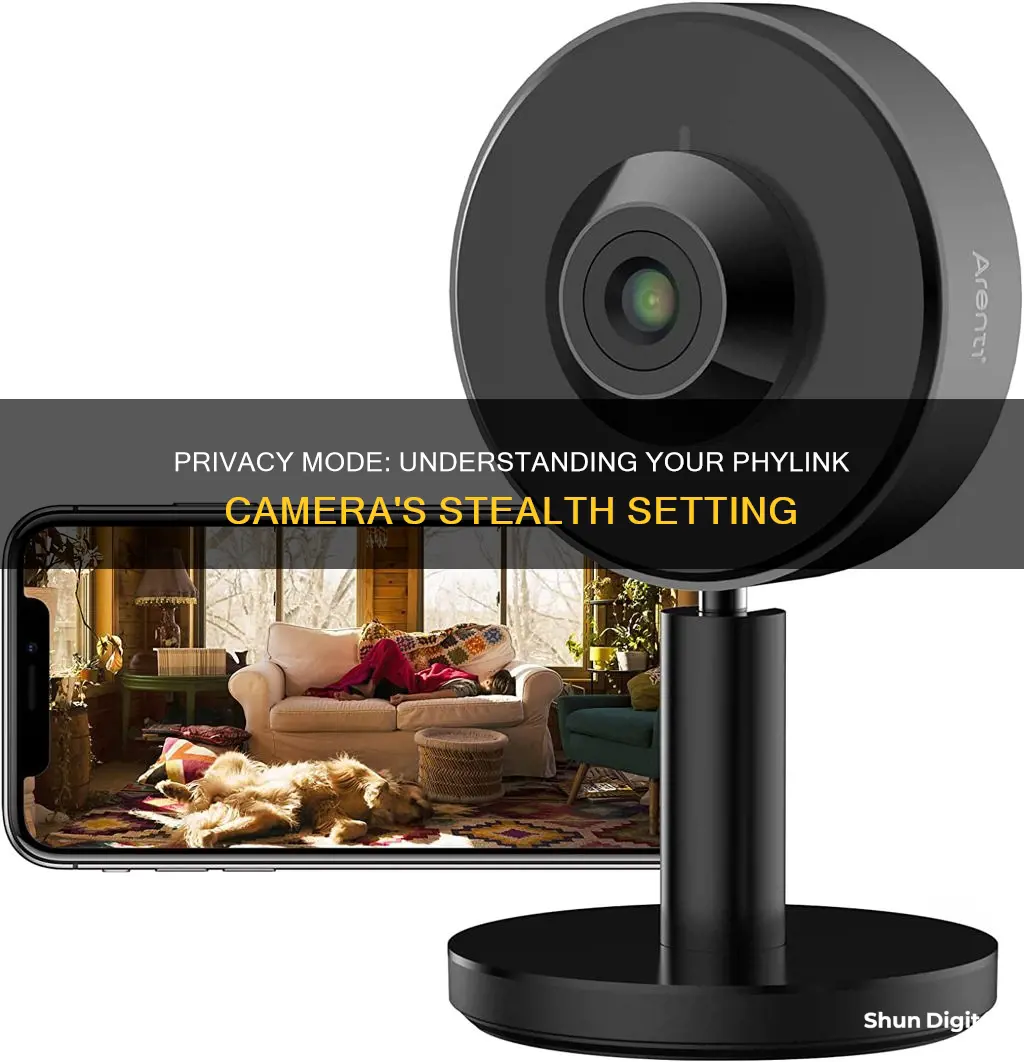
Phylink cameras are IP cameras that can be used for surveillance and security purposes. They can be set up both indoors and outdoors and can be controlled remotely from any PC or laptop. The cameras offer features such as motion detection, night vision, and wireless connectivity. In terms of privacy mode, while there is no explicit mention of this term in the user manual, the camera does have a feature called Privacy Masking which might be related to what you are looking for. This feature allows you to block out specific areas within the camera's field of view, ensuring that those areas are not recorded or transmitted. This could be useful if you want to protect the privacy of individuals or sensitive information within the camera's line of sight.
What You'll Learn

How to set up a Phylink camera
Setting up a Phylink camera involves several steps, from hardware installation to wireless setup. Here is a detailed guide on how to set up a Phylink camera:
Hardware Installation
- Ensure you meet the minimum system requirements, including a compatible web browser (Safari, Mozilla Firefox, Google Chrome, etc.) and necessary plug-ins (Adobe Flash).
- For standalone recording without a computer, you will need a MicroSD or MicroSDHC memory card.
- Decide on your power source: the included AC adapter or a PoE injector/switch (not included). Phylink outdoor cameras support Power over Ethernet (PoE).
- Mount the Wi-Fi antenna and the weatherproof junction box.
- Position and mount the camera, considering factors such as range and network compatibility (Phylink cameras are only compatible with 2.4GHz networks).
- Adjust the sunshade if necessary for optimal night vision range.
Software Installation
- Connect the camera directly to your router using an Ethernet cable.
- Set up Wi-Fi via an iOS or Android device:
- Open the app and click the "Type UID and password" menu.
- Manually enter the "UID" from the sticker on the camera cable.
- Follow the on-screen instructions to select your wireless network, enter your password, and complete the setup.
Alternatively, you can set up the camera on a PC/Mac using the Phylink Camera Live software provided on the included CD or downloaded from the technical support website.
Camera Configuration
- Access the camera using the Camera Live software (P2P method) or via a web browser (TCP/HTTP method).
- Configure various settings, including stream, image, night vision, network, and storage settings, according to your preferences and requirements.
- Set up motion detection and scheduling as needed.
- Configure email, FTP, and HTTP alarm sending options to receive alerts and snapshots when motion is detected.
- Update the camera's firmware periodically to take advantage of new features and bug fixes.
Finding the Chevy Camaro's Battery: Location and Access
You may want to see also

Privacy mode features
One of the key features is the ability to secure the camera with advanced encryption. Phylink cameras use the top-secure AES (Advanced Encryption Standard) with 128-bit secret keys for digital video encryption. This ensures that all data transmitted between the user and the camera is encrypted, preventing unauthorised access to information.
Phylink cameras also offer flexible accessing methods, including peer-to-peer and TCP/HTTP connections. The peer-to-peer method, available through the PHYCAM app or Phylink Camera Live software, automatically establishes a direct connection to the camera. This provides an easy and secure way for users to access their camera feed.
Additionally, Phylink cameras are compatible with various software applications that enhance privacy and security. For example, Camlytics smart camera software offers automatic and manual discovery options for easy login and camera viewing. iSpy and Agent DVR software also provide connection options and include a built-in wizard to simplify the setup process for Phylink cameras.
Furthermore, Phylink cameras support ONVIF connections, which offer another way to connect and access camera feeds securely. The cameras can also be integrated with third-party software, such as Blue Iris and iSpy, utilising the camera's RTSP and HTTP video and audio streaming capabilities.
Overall, the privacy mode features on Phylink cameras are designed to provide users with a high level of security and flexibility in how they access and utilise their camera feeds, ensuring peace of mind and convenience.
Displaying Camera Raw Data: A Step-by-Step Guide
You may want to see also

How to reset a camera to factory settings
To reset your Phylink camera to factory settings, you can use either a software reset or a hardware reset.
Software Reset
- Ensure your camera is powered up.
- Log in to the web server of the camera.
- Go to the Settings or Tools tab.
- Select the "Backup or Reset" option.
- Choose the "Software Reset" button.
Hardware Reset
- Ensure your camera is powered up.
- Find the reset button at the bottom of the camera.
- Press and hold the reset button for 10-15 seconds.
- You will see the status indicator LED go off for a few seconds, indicating that the reset is in progress.
- After the restart, the camera will be at factory settings, with the username and password both set to "admin".
Note: After resetting the camera, you will need to reconnect to your wireless network.
Crafting Camera Batteries: A Step-by-Step Guide
You may want to see also

How to set up wireless
To set up a wireless connection on your Phylink camera, you will first need to download the PHYCAM app from the App Store or Google Play, depending on your device. Ensure your camera is connected to your router with an Ethernet cable and powered up.
Open the app and follow the steps to add a new camera. You will need the UID of your camera, which can be found on the sticker on the camera cable. You will also need the default password, which is 'admin'.
Once your camera has been added, you can set up the wireless connection. Go to the Advanced Settings and select 'Network Setup'. Here, you will be able to search for available Wi-Fi networks. Select your network from the list and enter your password. After a successful setup, you can remove the Ethernet cable, and the camera should work wirelessly.
If you are setting up the wireless connection via a web browser, log in to your camera and go to 'Network > Wireless Setup'. Click 'Search' to find available Wi-Fi networks and select your network from the list. Do not type anything in the SSID field. Enter your network password and click 'Apply'. Click 'Test' to check if the setup was successful. You can then remove the Ethernet cable.
Alternatively, you can use Camlytics smart camera software for Windows PC to set up your camera. This software offers automatic and manual discovery options to connect to your camera.
Unleashing Camera Raw: A Guide to Unlocking the Power
You may want to see also

How to access the camera remotely
To access your Phylink camera remotely, you will need to set up a wireless connection using Wi-Fi.
Setting up a wireless connection:
First, ensure your wireless settings are completed and operational. To do this, connect your camera directly to your router with an Ethernet cable.
Next, you will need to set up your wireless connection via an iOS or Android device.
IOS:
Press the Save button and the camera will show up on the "My Camera" screen.
Android:
- Type the "UID" manually from the UID sticker on the camera cable.
- Type in your Wi-Fi password and press "OK" to save the settings.
After a successful wireless setup, remove the network cable. The camera should work through the wireless network after a short delay.
Accessing the camera remotely:
You can now access your camera remotely using the Phylink Camera Live software on PC/Mac. This software is provided on the included CD or can be downloaded from the Phylink technical support website.
Alternatively, you can access your camera via a web browser. Phylink cameras work on most web browsers, including Firefox, Internet Explorer, Microsoft Edge (Windows 10), Chrome, and Safari.
Please note that you will need to install a plug-in player, as the browser itself does not support video decoding and playback.
Reviving Camera Batteries: Simple Tricks to Try
You may want to see also
Frequently asked questions
Privacy mode on the Phylink camera allows users to protect their data with a password and AES encryption.
To set up privacy mode, change and protect your password in the camera settings.
You can change your password in the Login Password Modification section of the camera settings.
You can access the camera settings by logging in to your camera on a PC/laptop and navigating to the top menu of the camera settings page.







